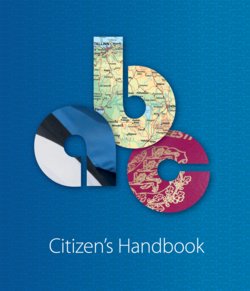Читать книгу Citizen’s Handbook - Mart Jagomägi - Страница 5
На сайте Литреса книга снята с продажи.
NATIONAL SYMBOLS
ОглавлениеEstonian flag
The Estonian flag is made up of three horizontal bands of colour of equal width: blue, black and white. The hoist to fly ratio of the flag is 7:11. Normal dimensions: 105×165 cm. In Estonian, the flag is also referred to as the “sinimustvalge” (‘blue-black-white’). The same colours are used in the national flag/state flag and the flag of the Estonian Students’ Society. Use of the Estonian flag is regulated by the Estonian Flag Act. (Estonian legislation is available in the electronic Riigi Teataja (State Gazette) at www.riigiteataja.ee.)
According to one of several interpretations, the blue colour represents faith in the future of the Estonian people, the black symbolises Estonian soil, national black coat and difficult past, and the white the promise of a brighter future.
The flag of the President of the Republic is an Estonian flag which bears the greater national coat of arms in the centre. The flag of the Estonian navy bears the lesser national coat of arms on both its sides. The Minister of Defence, as well as the police, border guard and customs institutions and post offices are entitled to use an Estonian flag bearing a specific emblem. The flag of a natural person or legal person (with the exception of the flag of the Estonian Students’ Society) may not be so similar to the Estonian flag that the two are likely to be confused.
Estonian coat of arms
The Estonian national coat of arms has two forms: the greater national coat of arms and the lesser national coat of arms. The national coat of arms has three blue lions passant guardant on a golden shield, with their faces turned towards the viewer. The greater national coat of arms has two golden oak branches; the lesser coat of arms lacks these branches. The national coat of arms has been established by the National Coat of Arms Act.
Estonian national anthem
The national anthem of the Republic of Estonia is the choir song “Mu isamaa, mu õnn ja rõõm”, music by Finnish composer Fredrik Pacius, lyrics in Estonian by Johann Voldemar Jannsen. The melody of the national anthem of Estonia is also used in the national anthem of Finland. The anthem was officially adopted in 1920, after the Estonian War of Independence. The Estonian national anthem has not been established and performance thereof is not governed by law. The tradition is that when the anthem is performed, people stand up and sing along.
| Mu isamaa, mu õnn ja rõõm | English version |
| Mu isamaa, mu õnn ja rõõm, kui kaunis oled sa! Ei leia mina iial teal see suure, laia ilma peal, mis mul nii armas oleks ka, kui sa, mu isamaa! | My fatherland, my joy and happiness, How beautiful you are! I shall not find such ever In this huge wide world Which would be so dear to me As you, my fatherland! |
| Sa oled mind ju sünnitand ja üles kasvatand; sind tänan mina alati ja jään sull’ truuiks surmani, mul kõige armsam oled sa, mu kallis isamaa! | You have given me birth And raised me up; I shall thank you always And remain faithful to you ‘til death, To me most beloved are you, My precious fatherland! |
| Su üle Jumal valvaku, mu armas isamaa! Ta olgu sinu kaitseja ja võtku rohkest õnnista, mis iial ette võtad sa, mu kallis isamaa! | May God watch over you, My precious fatherland! Let Him be your defender And provide bountiful blessings For whatever you undertake, My precious fatherland! |
